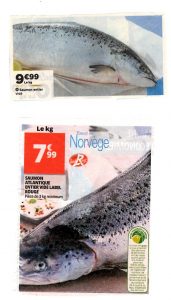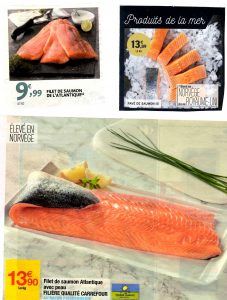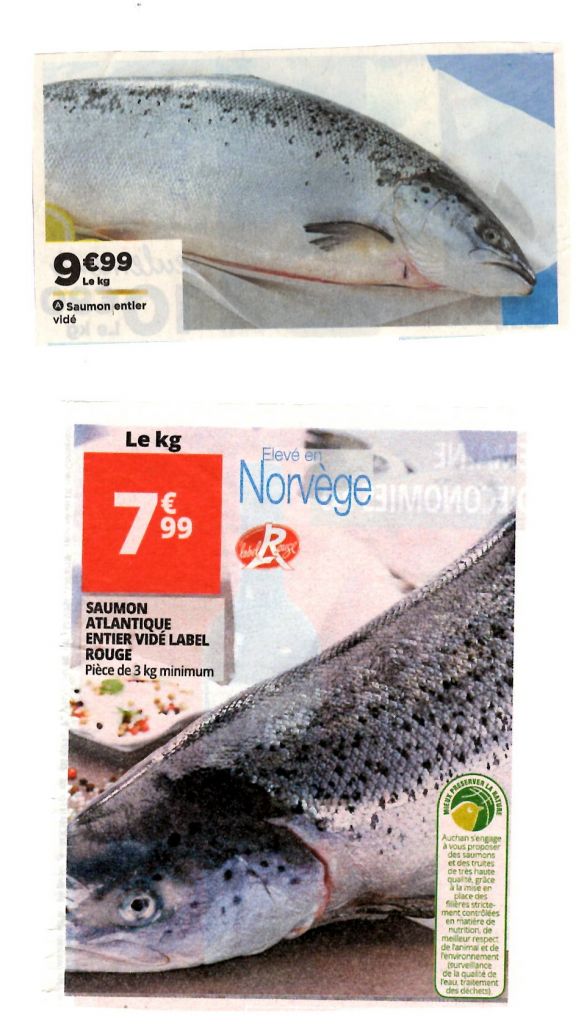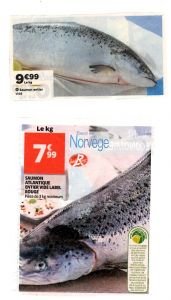Down in France: iLAKS recently reported that France has historically been one of Norway’s most important customers for salmon. The French market is still important, but French consumers have sharply reduced their purchases. To date, imports of Norwegian salmon into France have fallen from 86,000 tonnes to about 78,500 tonnes; a fall of 8.8 percent. iLAKS point out that this fall is not matched anywhere else in Europe, except perhaps Poland, and that otherwise, overall exports from Norway have remained largely stable.
Intrafish also looked at the French market, although in terms of smoked salmon. They say demand for smoked salmon has flattened. The reason for the poor consumer response is that salmon prices have become too high making processing by smokers to expensive.
We, at Callander McDowell, have recently returned from France where we have been conducting our usual pre-Christmas check on the retail sector. For the last four years, we have reported that the salmon market for Christmas, has been in our view, rather depressing. The effect of high prices has been extremely noticeable in store as both the amount of fresh and smoked product on display is much reduced, and more importantly, less visible. These observations may not have been immediately translated into reduced sales, but now it does seem from these reports, that volumes will be down this year.
Our expectation was low for our recent visit and unfortunately, we were not disappointed. It is possible that stores are leaving Christmas to the last minute but there are plenty of stacks of Christmas chocolates to be seen in the aisles. It is just salmon that seems to have done a disappearing act.
Some of the larger stores belonging to the major chains do have a bit more smoked salmon than usual, mainly, as in previous years, from Laberyrie, but otherwise there is very little to be seen. Smoked salmon was available at a range of prices, but most stores had packs selling on promotion at €20-25/kg. There were a handful of offers on salmon from the fresh fish counter but nothing spectacular. Most noticeable was the absence of whole fish. Even the couple of stores offering the fish on promotion, had few fish on display.
The best (only) deals this year:
Auchan – whole salmon Label Rouge € 7.99/kg special
Casino – whole salmon €9.99/kg
Carrefour – Salmon fillet €13.90/kg (cf whole fish €14.99/kg)
Cora – Salmon fillet €13.90/kg
Intermarche – Salmon portions €13.89/kg
LeClerc – Salmon fillet €9.99/kg (although out of stock at time of visit)


Catastrophic: The National newspaper reports that there has been a catastrophic failure of the salmon run in Argyll’s River Awe which has prompted demands for the closure of some fish farms and a review of the expansion of the industry. This year’s run is by far the lowest since records began in 1964 with a count of just 480 fish compared with 807 in 2016. The previous lowest was 781 fish in 1998.
Roger Brook, chairman of the Argyll District Salmon Fishery Board said that ‘This year’s salmon count on the River Awe is incontrovertible evidence that the decline in wild fish in salmon farming’s southern heartland has become critical’. Mr Brook has called on the Scottish Government to review its policy on the expansion of the salmon aquaculture industry without first addressing the negative impacts. ‘Expansion of the aquaculture industry without greater regulatory control is sounding the death knell for viable salmon populations in most of the West Highlands and Islands.’
Mr Brook’s comments in ‘The National’ originated in a press release issued by Salmon & Trout Conservation Scotland. Their Andrew Graham Stewart added that if the crisis in wild salmon numbers is to be halted then Scottish Ministers must be given the necessary powers to control the proper siting of salmon farms and the level of sea lice.
Mr Brook and Mr Graham Stewart clearly link the failure of the River Awe salmon run to the presence of the salmon farming industry, but dare we, at Callander McDowell, suggest that they have not provided a single piece of evidence to support their claim. All the ‘evidence’ is largely circumstantial. The salmon run has definitely failed and there are salmon farms in the area, but whether the two are linked is another question.
Certainly, Salmon & Trout Conservation Scotland believe they are. This week, Andrew Graham Stewart of S&TCS appeared on BBC TV’s ‘The One Show’ feature about salmon farming. He said ‘Once the sea lice get into the salmon farms they are a perfect breeding reservoir for those sea lice. Sea lice emanating from salmon farms are killing wild fish’. The interviewer asked: ‘Do the salmon farms make the numbers much worse’. Mr Graham Stewart replied: ‘Yes they do. The evidence for that is that on the east coast and the north coast of Scotland we’ve still got reasonably healthy populations of wild salmon and sea trout. We haven’t got that in the west Highland and Islands where you’ve got salmon farms.’
We, at Callander McDowell, have heard that filming for ‘The One Show’ occurred only very recently so we were surprised to hear Mr Graham Stewart refer to salmon populations from the east coast. The comparison of west and east coast salmon catches has very much been at the heart of the S&TCS campaign against salmon farming and was the central theme of their petition that has led to the instigation of the Parliamentary Enquiry. Our surprise comes from the fact that whilst we, as Mr Graham Stewart likes to point out, are not part of the angling community, he is, yet he seems unaware of the current state of wild salmon populations along the east coast. Perhaps, this is because he is so immersed in his crusade against the salmon farming industry, that he remains unaware of what is happening to salmon elsewhere.
A report in the Times newspaper this week also delved into the issue of declining wild salmon stocks. However, unlike the River Awe, which is located on Scotland’s west coast, the river featured is on the east coast. The River Tweed is one of the best-known salmon rivers in Scotland yet the Times reports that the locals are gloomy about what seems to have been the worst salmon season for 40 years. They say that the river is in trouble.
In 2013, the River Tweed had a bumper year with 14,794 salmon caught by anglers. This year, the figure is estimated to be around 6,000 fish. With less salmon being caught, proprietors had to slash prices by up to 75% to attract anglers to come and fish. It is said that a major downturn would be devastating for the area. Former chairman of the Tweed Commission, Andrew Douglas-Home said takings in shops and hotels were already down. He added that he used to employ four boatmen and now it’s just two.
Mr Douglas-Home said that the real issue was the sharp fall in the number of grilse. He fears that something has happened to the fish whilst at sea and as a result the grilse are missing.
However, it is not just the Tweed that is suffering along the east coast. Through Twitter, we learned that the River Tay Fishery Board has just published its annual report for 2017. The final total has not been confirmed, but it is thought that it may not reach 5,000 fish. They say this would make 2017 the poorest angling season in terms of reported catches since the 1950’s and possibly, the lowest ever recorded. They point out that the River Tay was not the only river to be affected in 2017 with problems appearing to be widespread. The board say that the most likely reason for the collapse in catches is, once again, a marine one.
It therefore seems that the poor run in the River Awe this year is not unique, nor limited to the west coast. Scotland’s most important salmon rivers also appear to be affected. Those connected to these rivers have stated that they believe the problem to be out at sea, so the obvious question is if it is issues in the marine environment that are causing the decline on the east coast, why could the same marine issues not be causing the declines on the west coast?
Does it really seem plausible that wild fish numbers on the east coast are in decline for a different reason to wild fish numbers on the west coast? Scientists at Marine Scotland Science appear to think so. In a briefing document, they say that it is not possible to compare catches from east and west coast rivers as a way of determining whether salmon farms are having an impact on wild fish stocks and that it is plausible that wild fish numbers could be declining on the east coast for differing reasons to those on the west. Their comments were specifically directed to sea trout catches as numbers of this species have declined over recent decades in areas where there are salmon farms and also in areas where there isn’t. When these scientists made this comment, salmon catches from the east coast were in a healthier position than they are today so they did not include salmon in their evaluation. However, the situation is very different today and it seems that wild salmon catches are in decline on both coasts. If marine issues are to blame on the east coast, then why not on the west too. Blaming salmon farming for the declines is just too convenient.
Critics will claim that west coast salmon populations have been in decline for much longer than those on the east suggesting something else is at play. However, east and west coast rivers are not alike. The River Tay, for example is 188 km long whereas the length of River Awe is just 6km. Changes to the stock are likely to occur much more rapidly in the shorter west coast rivers than the major rivers of the east coast, whose large size has likely acted as a buffer against many changes.
Both TV and newspapers are full of stories about the massive changes that are affecting the environment throughout the globe. Wild salmon and sea trout are not excluded from the affects of such changes. However, it does seem that those who blame salmon farming for the ills of the wild fish sector fail to see the wider picture. In the meantime, we certainly hope that the Scottish Government catch data figures for 2017 are published before the Parliamentary Enquiry gets underway because it will become increasingly clear that imposing more stringent controls on salmon farming will not be akin to waving a magic wand. The problems for wild salmon and sea trout reach much further than the west coast aquaculture zone.
Great news: Although we saw this via Twitter rather than the usual press stories, it is of interest following the criticism of the salmon farming industry on the BBC TV One Show. In October, when the announcement was made, all the mainland sites operated by Loch Duart Salmon had a zero sea lice count. This was due to the use of cleaner fish although other preventative measures such as skirts are also used.
This is great news from Loch Duart and demonstrates that the salmon farming industry can live in harmony with the wild fish sector. We are sure other farming companies will be able to make similar claims in the not too distant future. It will be interesting to see whether once sea lice are less of a problem, what impact that will have on wild fish stocks. Will west coast rivers be full of wild salmon again? We doubt it very much.
Fishy fraud: Oceana are at it again. This time in Ottawa, Canada. According to Seafood News they have been sampling fish from restaurants and grocery stores to see if the fish sampled matches to the name under which it was sold.
Oceana Canada revel that 45 out of 98 seafood samples were mislabelled. Previous studies have found that 41% of fish and seafood sold in restaurants and grocery stores is mislabelled but this is the first time they have targeted the Canadian capital. They found that restaurants were the worst offenders with 68% of sushi restaurants sampled and 51% of non-sushi restaurants were mislabelled whilst they claim that 18% of grocery store samples were mislabelled. Oceana call this mislabelling fraudulent. They say that seafood fraud cheats Canadian consumers and hurts local honest businesses as well as chef and seafood companies looking to buy sustainable seafood.
We, at Callander McDowell, are not impressed. We have made the same comments more than once before after Oceana have conducted their sampling. If what they found was fraud and potentially criminal, then why do they not provide specific examples, if not list every example of fraud they encountered. If they have found specific companies cheating the system, then clearly consumers and others should be made aware.
Oceana title the report of their findings ‘The Mystery Fish’ report. The real mystery is why their findings have to remain such a mystery!


